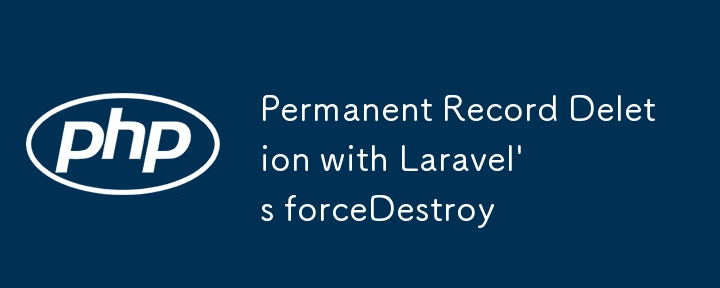Permanent Record Deletion with Laravel's forceDestroy

Laravel's soft deletion function maintains data integrity by retaining deleted records in the database. However, sometimes you need to permanently delete these records. The new forceDestroy method simplifies this process without having to retrieve the model before permanently deleting it.
This method is especially useful when performing cleanup operations, managing user data to comply with privacy compliance, or implementing an audit system that requires the complete removal of certain records from the database.
The following is an example of how to use the forceDestroy method:
use App\Models\Post; // 永久删除单个记录 Post::forceDestroy($id); // 删除多条记录 Post::forceDestroy([$id1, $id2, $id3]);
Let's look at a practical example of a data cleaning service:
<?php namespace App\Services;
use App\Models\User;
use App\Models\Content;
use Illuminate\Support\Facades\Log;
use App\Events\UserDataPurged;
class DataCleanupService
{
public function purgeInactiveUserData(int $monthsInactive = 12)
{
$inactiveUsers = User::onlyTrashed()
->where('deleted_at', '<', now()->subMonths($monthsInactive))
->pluck('id');
if ($inactiveUsers->isEmpty()) {
return ['message' => '没有需要清理的非活动用户'];
}
// 首先清理相关内容
$contentCount = Content::onlyTrashed()
->whereIn('user_id', $inactiveUsers)
->count();
Content::whereIn('user_id', $inactiveUsers)
->forceDestroy();
// 永久删除用户帐户
$userCount = User::forceDestroy($inactiveUsers);
Log::info('完成用户数据清理', [
'已删除用户数量' => $userCount,
'已删除内容数量' => $contentCount
]);
UserDataPurged::dispatch($inactiveUsers);
return [
'已清理用户数量' => $userCount,
'已清理内容数量' => $contentCount,
'message' => "已成功清理 {$userCount} 个非活动用户帐户"
];
}
}forceDestroy method simplifies permanent deletion operations, making your code more concise and efficient when managing soft delete records.
The above is the detailed content of Permanent Record Deletion with Laravel's forceDestroy. For more information, please follow other related articles on the PHP Chinese website!

Hot AI Tools

Undresser.AI Undress
AI-powered app for creating realistic nude photos

AI Clothes Remover
Online AI tool for removing clothes from photos.

Undress AI Tool
Undress images for free

Clothoff.io
AI clothes remover

Video Face Swap
Swap faces in any video effortlessly with our completely free AI face swap tool!

Hot Article

Hot Tools

Notepad++7.3.1
Easy-to-use and free code editor

SublimeText3 Chinese version
Chinese version, very easy to use

Zend Studio 13.0.1
Powerful PHP integrated development environment

Dreamweaver CS6
Visual web development tools

SublimeText3 Mac version
God-level code editing software (SublimeText3)

Hot Topics
 Alipay PHP SDK transfer error: How to solve the problem of 'Cannot declare class SignData'?
Apr 01, 2025 am 07:21 AM
Alipay PHP SDK transfer error: How to solve the problem of 'Cannot declare class SignData'?
Apr 01, 2025 am 07:21 AM
Alipay PHP...
 Explain JSON Web Tokens (JWT) and their use case in PHP APIs.
Apr 05, 2025 am 12:04 AM
Explain JSON Web Tokens (JWT) and their use case in PHP APIs.
Apr 05, 2025 am 12:04 AM
JWT is an open standard based on JSON, used to securely transmit information between parties, mainly for identity authentication and information exchange. 1. JWT consists of three parts: Header, Payload and Signature. 2. The working principle of JWT includes three steps: generating JWT, verifying JWT and parsing Payload. 3. When using JWT for authentication in PHP, JWT can be generated and verified, and user role and permission information can be included in advanced usage. 4. Common errors include signature verification failure, token expiration, and payload oversized. Debugging skills include using debugging tools and logging. 5. Performance optimization and best practices include using appropriate signature algorithms, setting validity periods reasonably,
 How does session hijacking work and how can you mitigate it in PHP?
Apr 06, 2025 am 12:02 AM
How does session hijacking work and how can you mitigate it in PHP?
Apr 06, 2025 am 12:02 AM
Session hijacking can be achieved through the following steps: 1. Obtain the session ID, 2. Use the session ID, 3. Keep the session active. The methods to prevent session hijacking in PHP include: 1. Use the session_regenerate_id() function to regenerate the session ID, 2. Store session data through the database, 3. Ensure that all session data is transmitted through HTTPS.
 Describe the SOLID principles and how they apply to PHP development.
Apr 03, 2025 am 12:04 AM
Describe the SOLID principles and how they apply to PHP development.
Apr 03, 2025 am 12:04 AM
The application of SOLID principle in PHP development includes: 1. Single responsibility principle (SRP): Each class is responsible for only one function. 2. Open and close principle (OCP): Changes are achieved through extension rather than modification. 3. Lisch's Substitution Principle (LSP): Subclasses can replace base classes without affecting program accuracy. 4. Interface isolation principle (ISP): Use fine-grained interfaces to avoid dependencies and unused methods. 5. Dependency inversion principle (DIP): High and low-level modules rely on abstraction and are implemented through dependency injection.
 How to debug CLI mode in PHPStorm?
Apr 01, 2025 pm 02:57 PM
How to debug CLI mode in PHPStorm?
Apr 01, 2025 pm 02:57 PM
How to debug CLI mode in PHPStorm? When developing with PHPStorm, sometimes we need to debug PHP in command line interface (CLI) mode...
 Framework Security Features: Protecting against vulnerabilities.
Mar 28, 2025 pm 05:11 PM
Framework Security Features: Protecting against vulnerabilities.
Mar 28, 2025 pm 05:11 PM
Article discusses essential security features in frameworks to protect against vulnerabilities, including input validation, authentication, and regular updates.
 How to automatically set permissions of unixsocket after system restart?
Mar 31, 2025 pm 11:54 PM
How to automatically set permissions of unixsocket after system restart?
Mar 31, 2025 pm 11:54 PM
How to automatically set the permissions of unixsocket after the system restarts. Every time the system restarts, we need to execute the following command to modify the permissions of unixsocket: sudo...
 Explain late static binding in PHP (static::).
Apr 03, 2025 am 12:04 AM
Explain late static binding in PHP (static::).
Apr 03, 2025 am 12:04 AM
Static binding (static::) implements late static binding (LSB) in PHP, allowing calling classes to be referenced in static contexts rather than defining classes. 1) The parsing process is performed at runtime, 2) Look up the call class in the inheritance relationship, 3) It may bring performance overhead.






